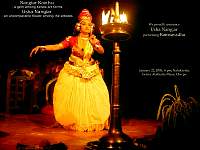|
Nangiarkoothu Nangiarkoothu is the solo women dance - theatre of
ancient Kerala performed by the Nangiar
women (women of Nambiar Community). Nangiarkoothu
exists as a part of the Koodiyattam theatre - as a part of the
Play Subhadra
Dhananjayam - an 11th century work by the Chera King Kulasekhara.
Nangiarkoothu is the Nirvahana
(telling the story
in flashback) of Subhadra's
friend Kalpalathika in
the second act of SubhadraDahnanjayam
. Main theme of Nangiarkoothu
is the story of Krishna.
Believed to be the only surviving link with the 2000 years old Sanskrit Theatre, Koodiyattam has been practiced, preserved and developed over the centuries by the Chakyar Community of Kerala. First public performance of this temple art form took place only in August 1956 due to the lead taken by the AIR. There does not exist any other art form like Nangiarkoothu which is an example of [sathvika abhinaya], which is based on the nine [rasas] emotions and this made the Koodiyattam the world famous. [rasas] are reflected in the face of the performer through the controlled movements of different parts of the face. Nangiarkoothu enacts elaborately the stories of Krishna with the help of hand gestures, facial expressions and eye movements. This ancient temple ritual art form has the costume and make-up [aharya] of goddess Bhagavathy. 'Kamsavadham' (the slaying of Kamsa)
- The story
Kamsavadham (the execution of Kamsa) is one of the rare pieces of Nangiarkoothu in which there are clear depiction of [navarasas] nine types of emotions apart from a wealth of examples of what is called the [pakarnnattam]. Pakarnnattam is the hall mark of Koodiyattam in which single person enacts different characters. This technique is also being tried in contemporary theatre also (for example Murali, the famous film actor presented recently the drama Lankalakshmi of C N Srikandan Nair depicting all the charaters by himself using the technique of [pakarnnattam].) Kamsa, the king of Mathura comes to know that Krishna, the eighth son of Devaki is going to be his killer. Kamsa is angry and sets a plan to kill Krishna by inviting him and his brother Balarama through the messenger Akroora for an Ayudhapooja called Dhanuryaga. The unafraid brothers enter the arms-house of Kamsa and break the mighty bow that was to be kept for the yaga. On the way they have a fight with an elephant 'Kuvalayapeedam' who attacked them. They kill the elephant and armed with the tusks of the elephant Balarama and Krishna enter the court of Kamsa.. [The performer, in seated position, describes above events as introduction. Afterwards she stands and starts enacting elaborately the remaining part]. [The performer enacts and elaborates three slokas describing |
Seeing
the brothers, different groups of people experience
varied feelings and emotions that are depicted by the performer. Two
angry
wrestlers are waiting
to fight with Balarama
and Krishna
(the
actress depicts [roudra
rasa]
the motion of anger).
Next
there is a group of ordinary people who
wonders the divinity seen on the faces of these rustic boys. (The
performer enacts
[rdbhutha
rasa]
the feeling
of wonder). Ladies
in the court are quite enchanted by the
beauty of Krishna.
They do not believe the story that Kamadeva
was killed by Siva
using his third eye since they see Kamadeva
in flesh and blood in front of them.
They steal glances with Krishna
(enacting
of [vipralampba
sringara]).
Gopas,
friends of Krishna
are at hasyabhava
and they make fun of
the Mathura people on seeing their varied
emotions (enacts [hasyabhava]).
Kings from sister
countries are so overconfident that they are
sure that the brothers can easily be defeated. They are sitting with
the
feeling of valour (
enacts [veera
rasa]
the emotion of valour).
It is only now that
Devaki
and Vasudeva
( mother and father of Krishna) see their son. Their
happiness is unbounded. Suddenly it is changed to the feeling of sorrow
since they see warriors and wrestlers who will jump on the little boys
at any time (enacting
of [karuna
rasa]).
Sitting
on his throne, Kamsa
sees the brothers. He has already heard
about their
adventures. Seeing Krishna there is no doubt in Kamsa's
mind that the boy is going to be his assassinator. He is afraid to his
core (enacting
[bhayanaka
rasa] the
feeling of fear).
Those
people who do not know Krishna
feel that it is unethical for the strong
and mighty fighters are being allowed to fight with weak Krishna
and Balarama.
They are
ready to go to avoid the witnessing of this injustice (enacting
[beebhatsa]).
Rishis who
know the reality of Krishna are
happy and go into meditation ([santa
rasa]).
Yadavas know that their
saviour has come at last (enacting
[bhakti
rasa]).
Thus
creating different
feelings in the mind of the courtiers depending
on their mental make up and personalities Krishna enters the court
with
his brother Balarama.
Wrestlers’
Chanura and Mushtika,
challenge Rama
and Krishna.
During the fight the wrestlers are killed.
Krishna
jumps to the throne of Kamsa,
pulls him down and sitting on his body plucks out his head and
throws it away. Krishna
dances on the dead body of Kamsa.
Gods and goddesses shower flowers on Krishna
while Yadavas
offer prayers to their saviour. Krishna is pleased and brings
happiness and pleasure
to everybody.
|
